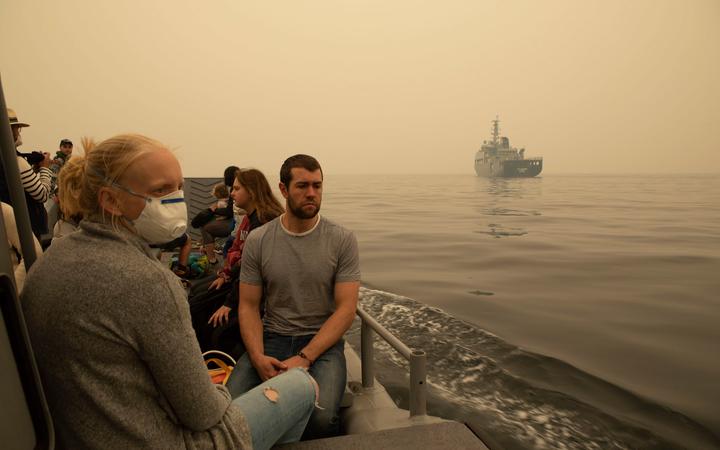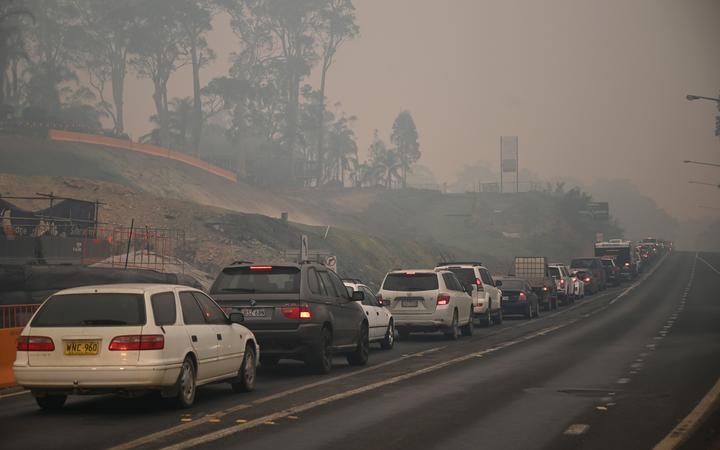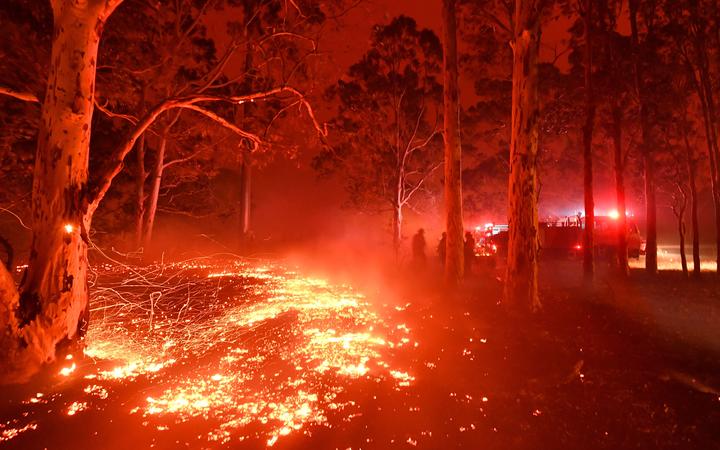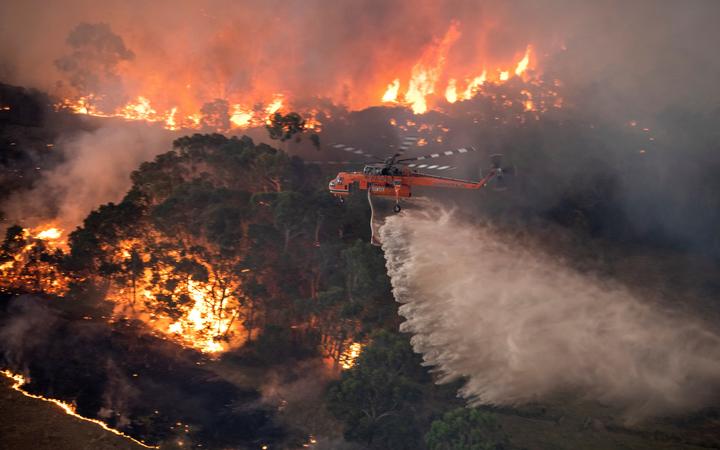Australia fires: Bushfires will burn out of control this weekend Featured
 Evacuation efforts in Mallacoota, Victoria. Photo: AFP / Royal Australian Navy
Evacuation efforts in Mallacoota, Victoria. Photo: AFP / Royal Australian Navy
4 January 2019. Authorities in Australia have urged tens of thousands of people to move to safety amid concerns that bushfires will burn out of control this weekend.

People being evacuated from Mallacoota, Victoria on a landing craft to MV Sycamore, during bushfire relief efforts. Photo: AFP / Royal Australian Navy
"If you don't need to be in the area, you need to leave," warned New South Wales (NSW) Premier Gladys Berejiklian.
Temperatures are expected to soar above 40C in parts of south-east Australia on Saturday, with strong winds increasing the fire danger.
Officials said it is expected to be a "very dangerous day".
NSW Rural Fire Service deputy commissioner Rob Rogers warned that fires could move "frighteningly" quickly on Saturday because of the extreme weather conditions.
"We are unfortunately very likely to lose homes but we will be very happy and call it a success if there are no lives lost," he said, according to the Sydney Morning Herald newspaper.
Since September, fires in Australia have killed at least 20 people, while dozens are missing.
What is the forecast for Saturday?
Meteorologists have forecast extreme heat and strong winds in fire-affected areas in south-east Australia on Saturday.
Victoria has declared a state of disaster in areas home to some 100,000 people, and urged residents to leave before Saturday.
"If they value their safety they must leave," Michael Grainger of the state's police emergency responders said. "I'd suggest personal belongings are of very, very little value in these circumstances."
He described the circumstances as "dire".

Cars lined up to leave the town of Batemans Bay in New South Wales to head north on 2 January. Photo: AFP
On Friday, the Australian navy evacuated some 1000 tourists and residents who were trapped in the fire-ravaged town of Mallacoota on the Victoria coast.
NSW has also declared a week-long state of emergency, and urged tens of thousands of residents and holidaymakers to evacuate coastal areas where a "tourist leave zone" has been declared.
"There is still a window for people to leave," Berejiklian said on Friday. "If you don't need to be in the area, you need to leave."
The volunteer NSW Rural Fire Service said many fires in the region could "pose a serious threat to life".
"If you are in the path of these fires leave tonight before conditions worsen tomorrow morning," it warned on Friday.
Speaking to the Sydney Morning Herald, NSW Transport Minister Andrew Constance described the forecast conditions as a "blast furnace".
In the state of South Australia, further west, fire crews have been battling a bushfire on Kangaroo Island.
Officials have described the blaze as "virtually impossible" and say it threatens to engulf most of Australia's third-largest island, according to ABC News.
Fires expected to spread in NSW
A total fire ban is in place across NSW with extreme fire danger in much of the state's south-east, and authorities are warning conditions could become catastrophic.
Existing fires are expected to spread significantly under difficult conditions.
An RFS map of predicted fire paths shows a blaze at Green Valley could impact nearly the entire Mount Kosciuszko National Park with either actual fire spread or ember attacks.
Rogers warned a stretch of fire that has crossed into Victoria could return on Saturday, potentially merging with another blaze and creating a fire front stretching up to 70 kilometres.
"We can't stop those fires. We can't stop the fires we already have."

Burning embers cover the ground as firefighters battle against bushfires around the town of Nowra in the Australian state of New South Wales on December 31, 2019. Photo: AFP
But he said the state was well prepared for the onslaught with more than 3000 firefighters in 700 appliances on the ground and hundreds more waiting to be deployed to the most serious blazes.
Closer to Sydney, another point of vulnerability is on the southern side of the Green Wattle Creek Blaze burning near Mittagong.
"Our strategy is to lay retardant on it ahead of it just to try and slow its progress so it doesn't get to places like Mittagong," Rogers said.
The RFS is also closely watching a section of the Gospers Mountain blaze, north-west of Penrith, where predictions suggest fire and ember attacks could creep towards Sydney.
Rogers said there was a "breakout" there on Friday and while crews were confident of getting on top of it, the blaze remained a concern.
Huge fire fronts raging across Victoria
In Victoria, a huge complex of fires in East Gippsland stretches from north of Bairnsdale to the New South Wales border, with areas not already burnt under threat.
Another complex of fires in the Alpine region, started by dry lightning this week, is threatening a number of ski resorts and could join up with a third group of fires burning in the north-east of the state, around Corryong and Walwa.
Victoria's Emergency Management Commissioner Andrew Crisp said the state had "literally hundreds and hundreds of kilometres of active fire edge, of uncontained fire".
"The major risk is the fires we don't know about, the new starts," he said.

Helicopter fighting a bushfire near Bairnsdale in Victoria's East Gippsland region on 31 December 2019. Photo: AFP / State Government of Victoria
Authorities are urging people across affected areas not to become complacent. Milder weather is predicted for the morning, but there will be an escalation in bushfire behaviour later in the day.
The Bureau of Meteorology is expecting hot, dry north-westerly winds ahead of a southerly change.
The change is expected to reach Victoria's south-west in the early hours of Saturday morning, before crossing metropolitan Melbourne about 8:00am.
It will push into the Gippsland region - the area most affected by the recent fires - by the early afternoon and will move into the north-east of the state by evening and later on into NSW.
Temperatures on Sunday are expected to drop dramatically, into the high-teens and low-20s.
What's the background?
Australian Prime Minister Scott Morrison visited bushfire-hit town of Cobargo in New South Wales earlier this week. Photo: Screengrab / ABC
The fires in Australia began in September. In addition to the fatalities, they have so far destroyed more than 1300 homes, as well as millions of acres of bushland.
Meteorologists say a climate system in the Indian Ocean, known as the dipole, is the main driver behind the extreme heat in Australia.
However, many parts of Australia have been in drought conditions, some for years, which has made it easier for the fires to spread and grow.
Prime Minister Scott Morrison has been crtiticised for his response. In a news conference on Friday, he said he understood that people had "suffered a great lot" and were "feeling very raw".
- BBC / ABC

